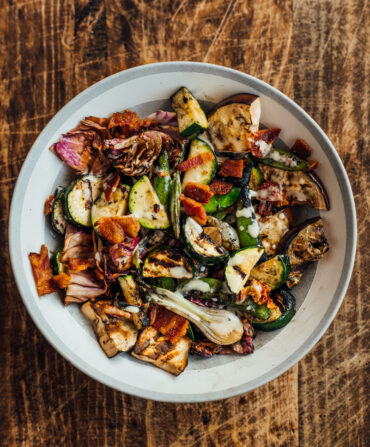A few years back, Kelsey Barnard Clark added raised garden beds to her backyard in Dothan, Alabama. The executive chef and owner of KBC restaurant, she grew up eating collards, but growing them herself solidified her love of the leafy greens. “It’s their hardiness and sturdiness that really impress me,” says the Top Chef winner and author of the cookbook Southern Grit. “Collards are one of those rare plants that actually thrive, sweeten, and perk up at that first frost. I reserve an entire raised bed just to get to know my favorite leafy green every year.” One standout variety at the top of her annual planting and eating list is Ole Timey Blue Collards (a.k.a. Alabama Blues), which have been grown in Fayette County, Alabama, for more than a hundred years. The two-foot-tall plants, with striking bluish leaves and purple veins, reach peak sweetness after a couple of frosts, making late winter theideal time for harvesting and cooking them. Sweet with the perfect hit of bitterness (similar to kale), Alabama Blues are delicious simmered with pork (see recipe), and try working any leftovers into a cheesy dip (see tip). For a quick at-home prep that even her young children will devour, Clark’s go-to is collard chips: Just tear the leaves into pieces and bake, or fry, with a touch of spice. If you find Ole Timey Blues at a farmers’ market or stand, make sure the leaves look hydrated and don’t have any dry spots. Wrap them in damp paper towels in the refrigerator and they’ll stay perky for up to a week. But for guaranteed freshness, you can’t beat growing your own (score seeds online at Seed Savers Exchange). Plant them and you won’t regret it, Clark says. “They’re your best friend in any garden.”
Ingredients
Smoked Sausage Collards (Yield: 4–6 servings)
2 lb. collard greens
4 cups chicken stock
3 tbsp. unsalted butter
2 dried whole chile peppers
3 cups Conecuh or other smoked pork sausage, finely chopped
3 cups yellow onion, thinly sliced
¼ cup apple cider vinegar
3 cloves garlic, thinly sliced
Pinch of red pepper flakes
Preparation
Clean collards by soaking in cold water for a few minutes. Remove and shake off excess water. Use a sharp knife to slice along the stalk to remove the leaves. Chiffonade the leaves by stacking them on top of one another, rolling them up, then slicing into 1-inch ribbons. Dice the stalks and set aside.
Place collard leaves and chicken stock in a Dutch oven over medium-high heat. Bring to a boil, then simmer for 30 minutes, uncovered. Drain leaves.
In a cast-iron skillet over medium heat, melt butter, then add peppers and sausage. Cook, stirring frequently, for 10 to 12 minutes, or until the fat has rendered and the sausage is brown. Remove sausage and peppers, leaving fat in the skillet.
Add diced collard stalks and onion and cook for 20 minutes over low heat, stirring frequently, until onion is caramelized. Raise heat to medium-high, add vinegar, garlic, and red pepper flakes, and cook for 5 minutes or until liquid is evaporated. Add sausage, peppers, and cooked greens to the skillet. Cook over low heat for 20 to 30 minutes, until any additional liquid cooks off and the greens are dark in color. Serve hot.
TIP: In a greased casserole dish, mix leftover cooked collards with ¼ to ½ cup each grated Parmesan and mayo (adjust based on your collards portion). Then cover with a layer of butter-soaked panko and grated Gouda. Bake until golden. Use as a dip for pork skins, tortilla chips, or pita chips.








